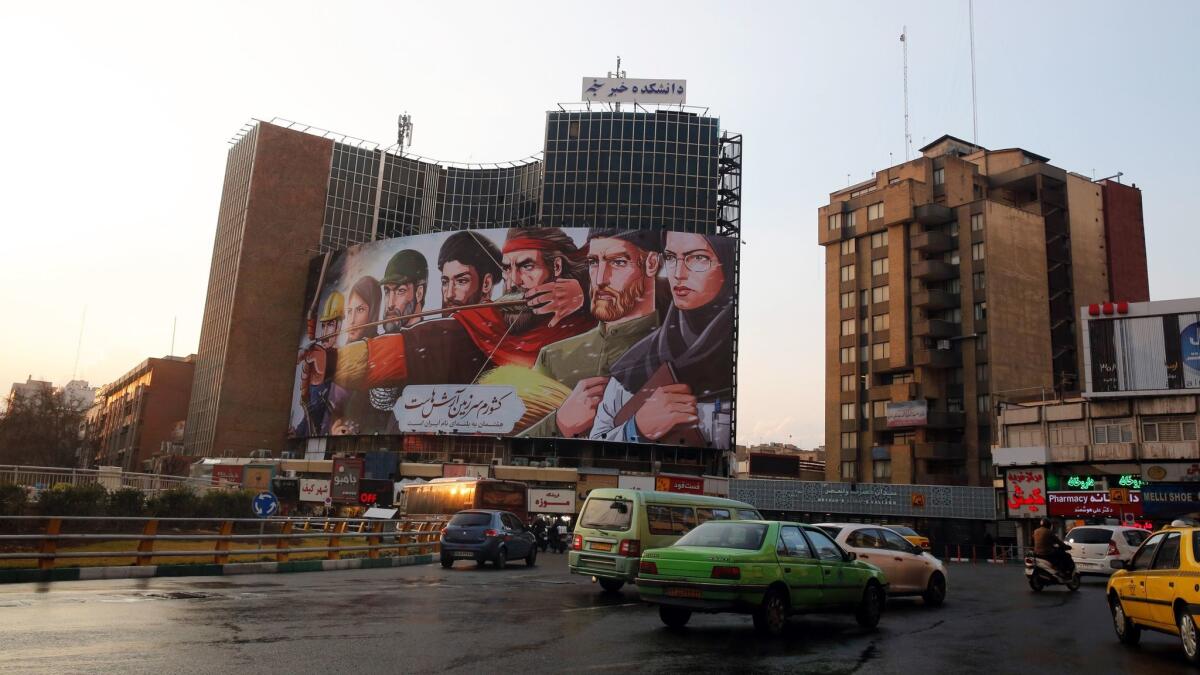In killing Gen. Qassem Suleimani, the U.S. gave Iran what it reveres: A martyr

In life he was a hero to many, but in death Gen. Qassem Suleimani became what all Iranians revere: a martyr.
As Suleimani’s casket made its way through the streets of Tehran, his image instantly became part of a near-sacred iconography that in times of turmoil and conflict has united and emboldened this nation against its enemies. Pictures and murals of Iran’s most glorified figures, including religious leaders and soldiers who died in the Iran-Iraq war, tower over cities and towns, as if protectors watching from on high.
President Trump’s decision to target Suleimani in an airstrike may have killed Iran’s most gifted military strategist, but it elevated the general to a pantheon of martyrs that has endured for centuries. Their images are sewn into a folklore that is at once government propaganda and a vivid reminder — some murals flash like rainbows over street corners — of how deep national devotion and the piety of Islam inspire the country.
“Religious leaders in Iran are extremely apt and capable in producing symbolism and creating a culture of politics in which they can incorporate nationalism and faith,” said Ali Akbar Mahdi, a sociology professor at Cal State Northridge. “They are utilizing all kinds of symbolism and tying it in sense of victimhood and how Shiites have suffered and now have to fight.”

Draped in thick sweaters to shield themselves from the cold winter air, several mourners who had gathered outside the funeral procession at Tehran University crouched down on the pavement, weeping as they buried their heads in their hands.
When he was alive, Suleimani had been regarded as a national hero by everyone from shopkeepers to the Islamic Republic’s top elites. In many ways, the outpouring over his death, and the images it has evoked, has been unmatched by anyone except the late Ayatollah Ruhollah Khomeini. Supreme leader Ayatollah Ali Khamenei, who had a close relationship with the 62-year-old salt-and-pepper-haired Suleimani, wept at his funeral and referred to him as a “living martyr.”
In the days since the U.S. drone attack that killed him, Suleimani’s visage, flickering on banners and posters and electronically beamed over Tehran, has become inescapable in the Islamic Republic and across much of the Middle East. His death has spurred a fierce anti-American backlash, and edged Iran closer to war as it threatens to walk away from the 2015 accord to limit its nuclear capabilities. Iran launched more than a dozen ballistic missiles that targeted at least two military bases used by U.S. and coalition forces in Iraq, the Pentagon said Tuesday night.

From the 1979 Islamic Revolution to the Iran-Iraq war of the 1980s and up to today’s wars in Syria, Iraq and Yemen, martyrdom — the idea that a person could sacrifice his life for both the nation and Islam — has helped shaped the country’s religious and political life. So potent are images here that paintings of soldiers who died in the Iran-Iraq war, which killed an estimated 500,000 Iraqis and Iranians, spurred young men from the provinces to take up arms.
The martyrdom of Suleimani is rooted in one of the most fundamental tenets in Shiite Islam: sacrificing oneself in the name of justice and against the oppressor. This tenet marks Islam’s second branch and emerged in the 7th century during battle of Karbala, where the well-known Shiite figure Imam Hussein was killed.
Throughout his time in that role, Suleimani, a construction worker who rose to be commander of the Quds Force, developed relationships with various militia and terrorist groups in Syria, Iraq and Yemen, helping to expand Iran’s regional influence. He also played a major role in the fight against Islamic State militants in Iraq in 2016.

While the temptation to draw comparisons of the fallout of Suleimani’s death to the martyrdom of others throughout Iranian history is strong, some scholars cautioned against it.
“That was a particular moment in Iran’s recent history. It has moved on from that culturally and politically,” said Afshon Ostovar, an assistant professor at the Naval Postgraduate School in Monterey, Calif. “People might think that Iranians love martyrdom or that Shiite Muslims aspire to martyrdom, and that this is a collective national goal of Iran, but that’s not true.”
But that’s not true of Suleimani’s legacy. Whereas other top leaders in Iran had to navigate internal domestic politics, which could be polarizing and dividing, Suleimani’s role as commander took him out of Iran and into different countries, helping him escape the factional fights happening at home and further enhancing his stature.
“He is considered a man who is able to move above the conflict, and if there has to be change in Iran, he was going to be that person to lead the transformation,” Mahdi of Cal State Northridge said.
More to Read
Start your day right
Sign up for Essential California for news, features and recommendations from the L.A. Times and beyond in your inbox six days a week.
You may occasionally receive promotional content from the Los Angeles Times.







